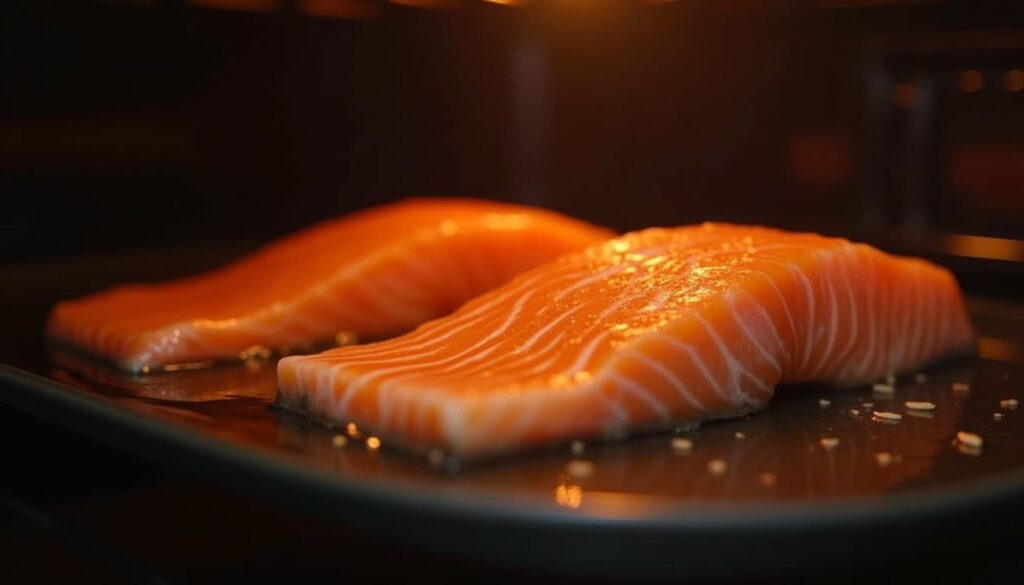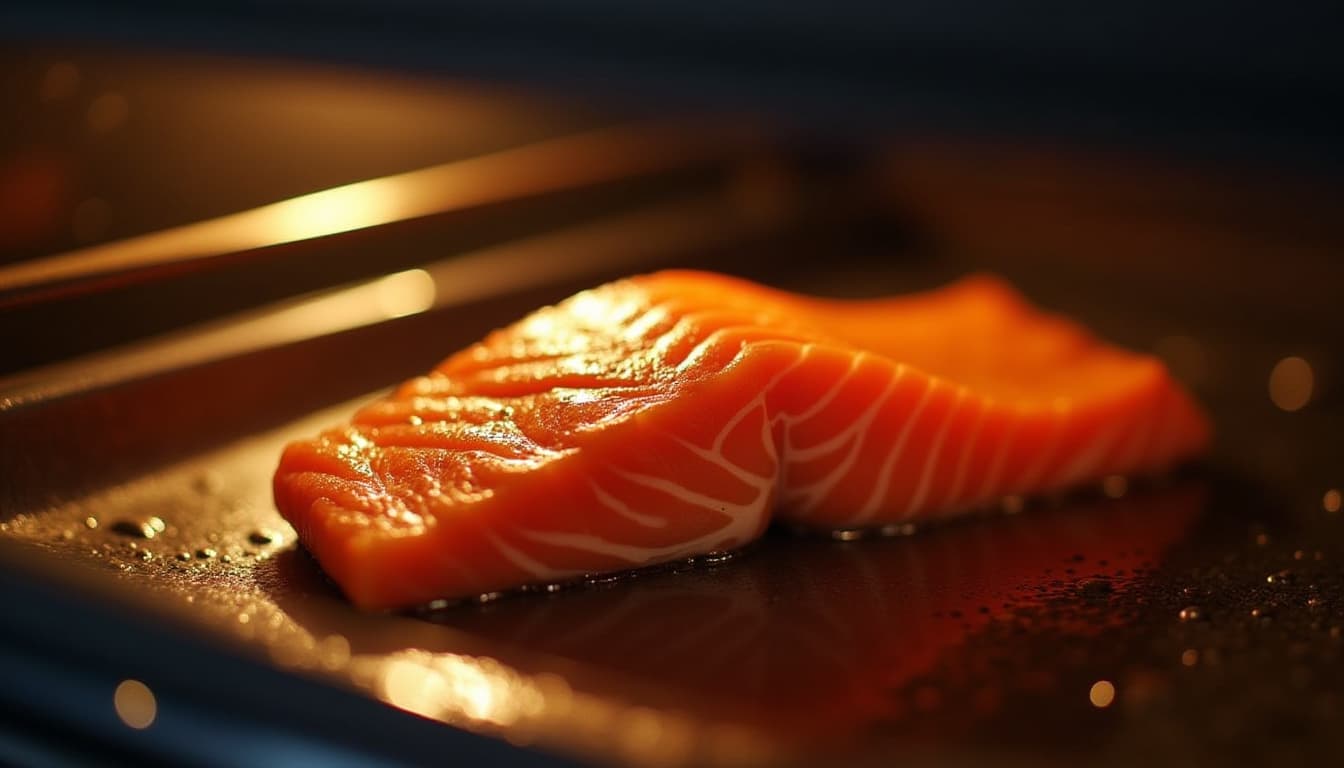Discover the ideal oven time for salmon, ensuring it’s perfectly cooked every time. This guide will give you all the details.
Wondering how long should salmon be cooked in the oven? This article provides all you need to know for perfectly cooked salmon every single time. Naturally, the cooking time depends on several factors. These include the thickness of the fillet and the oven temperature. This guide will cover those details, as well as helpful tips. We will explore how to ensure your salmon is not overcooked. Therefore, you will achieve a moist and delicious result. Additionally, you will learn how to check for doneness, and more.
Why Oven-Baked Salmon is a Naturally Good Choice
Oven-baked salmon is a healthy and easy meal. It’s a convenient way to cook salmon because it requires less hands-on time. Because baking salmon is simple, it’s a great option for both beginners and experienced cooks. The oven also distributes heat evenly. Consequently, your salmon will cook thoroughly and come out perfectly. This method brings out the natural flavors of the salmon. This method naturally enhances the taste.
Health Benefits of Salmon
Salmon is packed with nutrients. It’s a great source of protein and omega-3 fatty acids. These are very important for a healthy heart and brain. Additionally, salmon provides vitamins and minerals. These are essential for good health. Naturally, including salmon in your diet is a great way to boost your well-being. It’s a very good choice for a balanced diet. Furthermore, it is a protein-rich choice.
Convenience of Baking
Baking salmon is a very convenient method. Once the salmon is in the oven, it needs very little attention. This makes it perfect for busy weeknights. You can also prepare side dishes while the salmon is baking. Furthermore, clean-up is easy as there is less mess involved with baking. Therefore, baking salmon is a great way to cook a healthy meal, saving you time. It’s a great flexible option.
Factors Affecting Salmon Cooking Time in the Oven

Several factors influence how long should salmon be cooked in the oven. These factors include the thickness of the salmon fillet, oven temperature, and whether the salmon is fresh or frozen. Knowing these factors will help you adjust the baking time. Specifically, understanding these details will help you get a perfect result every time. You will be able to cook salmon like a pro.
Thickness of the Fillet
The thickness of the salmon fillet is one of the most important factors. Thicker fillets need longer cooking times than thinner ones. Generally, a one-inch thick fillet will take about 12-15 minutes to bake at 400°F (200°C). However, a thinner fillet might only take about 8-10 minutes. Accordingly, adjust your cooking time to match the thickness. It’s important to consider the exact size of the piece.
Oven Temperature
Oven temperature also has a big impact on the cooking time. Higher temperatures will cook the salmon faster. Lower temperatures will cook it slower. The most common temperature for baking salmon is between 375°F and 400°F (190°C and 200°C). This is the best way to get the best results. Indeed, you want to avoid cooking at a very high temperature. A temperature too high might dry out the salmon.
Fresh vs. Frozen Salmon
Naturally, fresh salmon will cook differently from frozen salmon. Frozen salmon needs a little more cooking time. It might also release more moisture during the cooking process. Therefore, if using frozen salmon, it’s best to thaw it first. Thawing it completely is key for best results. However, you can cook frozen salmon directly from the freezer with some added time. This will naturally increase your baking time.
Naturally Perfect Cooking Time Guidelines for Oven-Baked Salmon
While the above factors matter, here are some basic cooking guidelines. These will help you cook salmon perfectly every time. These guidelines are based on an oven temperature of 400°F (200°C). These are simply guidelines and you might need to adjust them based on your oven. Always check on the salmon regularly. They are simply the starting point, you might need to adapt them.
Standard Salmon Fillet (1-inch thick)
A standard salmon fillet that is about one inch thick needs to bake for about 12-15 minutes. This will ensure it is cooked through and still moist. However, you can check for doneness after 10 minutes. It is better to check a little early and then add extra time as needed. Basically, it is better to undercook than overcook the salmon.
Thin Salmon Fillet (Less than 1-inch thick)
A thin salmon fillet, or portions that are less than one inch thick, will cook quicker. It only needs about 8-10 minutes. It’s important to keep a close watch to prevent overcooking. Specifically, thin fillets overcook easily. Consequently, it’s important to check for doneness very carefully. Time will really be shorter with these thinner pieces.
Thick Salmon Fillet (Over 1-inch thick)
Thick salmon fillets, those that are over one inch thick, need a longer baking time. They usually require about 15-20 minutes. Additionally, you might want to use a lower oven temperature, around 375°F (190°C), to make sure the salmon cooks through. This helps it to cook evenly. A lower temperature might be safer for thicker cuts.
Checking for Naturally Done Salmon
Knowing how long should salmon be cooked in the oven is important. However, knowing how to check for doneness is equally important. Overcooked salmon is dry. Undercooked salmon is not safe to eat. Here are some tips on how to tell when your salmon is perfectly done. These are great tips for everyone who wants to cook salmon like a pro.
Flaking Test
The easiest way to check for doneness is the flaking test. Use a fork to gently press on the salmon. If it flakes easily, it’s ready. However, if it doesn’t flake easily, it needs more time. This is a very reliable method. Generally, you want the salmon to flake easily, but also be moist. This test works well with most fish.
Internal Temperature Check
You can also use a meat thermometer. The internal temperature of cooked salmon should reach 145°F (63°C). Indeed, this is the best way to be absolutely certain that the salmon is fully cooked. Insert the thermometer into the thickest part of the fillet. Therefore, a thermometer will always give you the most accurate result. Always check the temperature carefully.
Appearance Check
Naturally, you can also check the appearance of the salmon. Cooked salmon will have an opaque, pinkish color, while raw salmon looks translucent. Additionally, the edges of the salmon should look cooked. The changes in color also help with determining doneness. The color change is a good sign.
Naturally Enhancing the Flavor of Oven-Baked Salmon
While oven-baked salmon is delicious on its own, you can easily enhance its flavor. Using simple seasoning and other additives can make a big difference. These enhancements make the meal even more satisfying. Experimenting with different flavors is always fun and rewarding. Feel free to try new flavors every time you bake salmon.
Simple Seasoning Options
Salt, pepper, and a little lemon juice are the easiest ways to season salmon. These simple ingredients let the natural flavor of the salmon shine through. You can also add garlic powder, onion powder, or paprika. Additionally, fresh herbs like dill, parsley, or thyme are great for flavor. The simple seasoning is often the best choice.
Marinades and Glazes
For more complex flavors, try marinating the salmon before baking. A simple marinade could include soy sauce, honey, and ginger. Moreover, a glaze made with maple syrup and mustard is also a great option. You can try any glaze you prefer. Basically, the key is to marinate or glaze it for at least 30 minutes before baking. These can really elevate the flavor.
Serving Suggestions
Naturally, you should consider serving the salmon with a side dish. Roasted vegetables are always a good choice. Lemon wedges are great, as they compliment the salmon very well. Furthermore, consider a side of rice or quinoa to make a complete meal. The sides can enhance the entire meal. They will provide some great nutrients.
Naturally Healthy Variations for Oven-Baked Salmon
This recipe is very flexible. There are many healthy variations to explore. These variations can help you customize your meal based on your needs. Exploring different options is a great way to keep your diet interesting. Specifically, this meal is great because it has a lot of room for change. how long should salmon be cooked in the oven
Adding Vegetables
Baking vegetables with the salmon is a great way to make a full meal. Vegetables like asparagus, broccoli, and bell peppers all taste great when roasted. Additionally, you can add sliced onions or zucchini. The options are really endless. Specifically, this method makes clean-up easier. Moreover, you add more nutrients to your meal.
Using Different Seasoning and Herbs
You can try variations in the seasoning too. Different herbs and spices can change the flavor profile. Try Mediterranean herbs, such as oregano, and basil. Or try spicy blends for a kick. Furthermore, you can even use different kinds of citrus, like lime or orange. The seasoning is a place for lots of creativity.
Low carb Options
For a low carb meal, skip the rice or potatoes. You can just serve the salmon with vegetables and a side salad. Naturally, the salmon is already protein-rich. Therefore, it makes a great addition to a low carb diet. Consequently, it is a very good choice for people watching their carbohydrates. It’s also a satisfying choice.
Understanding Naturally Occurring Flavor Profiles
The taste of baked salmon is very delicate and refined. Understanding these naturally occurring flavors will help you to cook better. It also allows you to make your flavors even better. Here we’ll look at the details of the salmon’s taste profile.
The Balance of Flavors
Naturally, salmon has a rich, oily flavor with a hint of sweetness. The texture is also very important. When cooked perfectly, salmon should be moist and flaky. Indeed, the overall taste of salmon depends on this delicate balance. Knowing how the flavors work together is essential for success. how long should salmon be cooked in the oven
How Seasoning Affects the Flavor
Seasoning is key to enhancing the natural flavor of salmon. Salt and pepper will enhance the salmon’s flavor. However, other seasoning, such as garlic and lemon, will change the flavor profile completely. Therefore, it’s important to select your seasoning carefully. Your choices can add depth and complexity to the flavor.
The Impact of Freshness
The freshness of the salmon also plays a very important role in its overall flavor. Naturally, the freshest salmon will have a better taste and texture. Therefore, always aim to buy the freshest salmon you can find. Furthermore, it is important to use it quickly after buying. Freshness makes all the difference.
Common Mistakes to Avoid When Cooking Salmon
While baking salmon is very easy, it is also easy to make mistakes. However, avoiding common mistakes is key to getting the perfect dish. Learning from other people’s errors can save you from making them yourself. Here are some mistakes to be aware of. There are so many things you can do to make it better. how long should salmon be cooked in the oven
Overcooking the Salmon
Overcooking salmon is a very common mistake. Overcooked salmon is dry and not satisfying. Therefore, always check for doneness early. It is better to add a little more time than to overcook it. Specifically, watch your cooking times very carefully. Overcooked salmon is not enjoyable.
Under-seasoning the Salmon
Under-seasoning is another common error. Salmon needs salt and other seasoning to bring out its flavor. Accordingly, make sure you use enough salt, pepper, and other seasoning that you like. The seasoning really makes a big difference. Moreover, be sure to season generously. You can always add more after.
Not Preheating the Oven
Not preheating the oven will affect cooking time. Specifically, an oven that is not preheated will not cook evenly. Consequently, you should preheat your oven to the correct temperature. This ensures the best possible cooking results. Indeed, preheating is an essential step. Preheating will help you cook evenly.
Exploring Different Types of Salmon
There are several types of salmon, and each one has a slightly different taste and texture. Naturally, the type of salmon you pick might affect the cooking process. Therefore, knowing about different salmon types will be helpful. It will also help you pick the right one for your needs.
Wild-Caught Salmon
Wild-caught salmon is often considered to be the best in terms of flavor and nutrients. It tends to be leaner and has a more robust flavor. Wild salmon can also vary depending on where it was caught. Indeed, wild-caught salmon is often very rich in flavor.
Farmed Salmon
Farmed salmon is typically less expensive. However, it often has a higher fat content. The flavor tends to be more mild compared to wild salmon. Nevertheless, farmed salmon is still a great option for cooking. Farmed salmon is still protein-rich.
Different Varieties
There are several varieties of salmon, including King, Sockeye, and Coho. Each one has its own unique characteristics. Generally, King salmon is the richest, and Sockeye is very flavorful. Coho is a good middle option. Therefore, you may wish to explore the different types.
Frequently Asked Questions (FAQs)
Below are some common questions about cooking salmon in the oven.
How long should salmon be cooked in the oven at 350?
At 350°F (175°C), bake salmon fillets for about 15-20 minutes, depending on thickness. Always check for doneness.
What is the best temperature to cook salmon in the oven?
The best temperature to bake salmon is between 375°F and 400°F (190°C and 200°C). This gives a great result.
How do you keep salmon from drying out in the oven?
To keep salmon from drying out, don’t overcook it. Add a drizzle of olive oil before baking. You can also bake it wrapped in parchment paper.
Should salmon be covered when baking?
Covering the salmon while baking can help keep it moist. However, it’s not needed. Removing the cover for the last few minutes helps the top to brown.
Is it better to bake salmon skin up or down?
Bake salmon skin down. This helps the skin get crispy. It also helps keep the salmon moist. Generally, this method is most effective.

